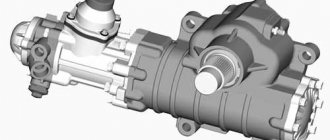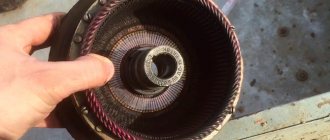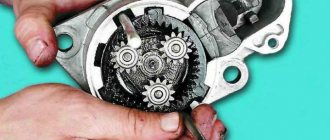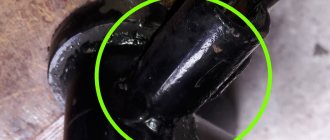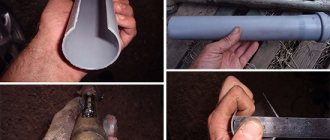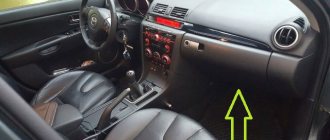Motorists know how much nerves are wasted when problems with power steering occur. The steering wheel behaves strangely and turns much more difficult at idle or low speeds. A whistling sound is heard from the pump bearing. Leakage of working fluid onto the engine or onto the road at the location of the unit. The rotation of the steering shaft is accompanied by extraneous sounds.
These inconveniences can affect not only the driver’s nervous health, but also driving safety. What to do if symptoms of a pump malfunction appear? How to replace this power steering part? Is it possible and how to carry out repair work yourself? We'll tell you more about everything below.
Symptoms of power steering pump malfunctions
Although the vane and vane pumps installed in the power steering design do not break down so often, we will still consider what the signs are and how to extend the service life of the pump.
You can extend the service life by the following actions:
- Change the fluid on time. Few people change the oil in their hydraulic booster, but it becomes old and loses its properties. Therefore, it is necessary to do this.
- Monitor the fluid level in the power steering reservoir.
- Try not to turn the steering wheel when the internal combustion engine is not running. If the fluid in the power steering system does not move, the pump overheats. The oil does not move if you turn it many times with the engine off.
- When changing the oil, make sure that no debris gets in.
If you follow the operating rules, the power steering will last a long time. Check the oil level periodically. When adding fluid, add only the same brand.
If you notice signs of problems with the power steering system, you should not drive fast or long distances until the causes are eliminated.
Signs of problems with power steering:
- If you have difficulty turning the steering wheel at idle and at low speeds. At high speeds there are no problems with turning the steering wheel.
- If you find a fluid leak from the power steering system.
- If you hear extraneous sounds while turning the steering wheel.
- If you hear a whistling or humming noise from the bearing. If the bearing is removed, there will be play when the pulley rolls.
We remove the found faults:
All we may need in the upcoming work is this!
- alcohol (White Spirit is best, also known as gasoline solvent or a can of WD40);
- sandpaper (from P2000 to P1000);
- cloth or soft paint brush;
- small needle file or file;
- electric drill;
We use sandpaper to clean the seats of the rotor blades.
Cleaning the rotor comes down to eliminating irregularities and burrs of the grooves, as well as grinding the rotor surface.
It is better to work with gloves, as the edges of the rotor are very sharp. Try to keep the movements smooth and uniform for smoother grinding. There is no consensus on the method of grinding the inner surface of the stator. If you have enough patience and time, you can try leveling it manually.
The algorithm is like this:
First, we do a rough cleaning with a file, then smooth it with coarse sandpaper and polish it with sandpaper.
It’s easier to adapt an electric drill using a drill and sandpaper. You’ll get a kind of mini-grinding machine by screwing sandpaper onto a drill with a diameter of at least 12 mm (against the movement of rotation of the drill). When grinding with a home-made unit, you should try to evenly distribute the load over the entire surface, unnecessarily without being overzealous and not forgetting to change the skin from the largest to the smallest.
Using a drill and sandpaper, we eliminate uneven surfaces of the stator.
Having finished with grinding, we will return the power steering pump to its original working condition. When performing the assembly process in the reverse order, it would be useful to first check whether the shaft rotates easily inside the pump itself.
The final touch will be to install the cover in place, with the preliminary installation of a new sealing gasket. During the assembly process itself, the cover is easily tightened with four bolts, which are best pulled crosswise, thereby achieving a uniform, precise fit of the cover plane to the stator.
Now the pump is now in new condition again. However, quite a lot of time will pass before this procedure will have to be repeated again!
Watch a video tutorial on how to repair a power steering pump yourself.
Watch a video lesson on how the power steering system works.
Power steering: what is it and what does it consist of?
Hydraulic power steering is a part of the steering mechanism that makes it easier to control the car when turning or hitting uneven roads. The hydraulic booster reduces the effort the driver puts on the steering wheel while driving. If you have a working hydraulic booster, it is much more comfortable for the driver to drive, there is less strain on his hands, and the parking process is easier.
We recommend: Airbags and tow trucks
Power steering components:
- Pump . The main part of the system. The belt connecting the booster to the crankshaft drives the pump, so the whole mechanism works when turning;
- Distributor . A high-pressure pump supplies oil to a distributor that is sensitive to the level and degree of contamination of the oil. If the tie rods are on the sides of the rack, then the piston is in the center of the body. There may be a different type of distributor. When the piston is on the side and the rods are in the center of the rack;
- Steering gear;
- Steering bipod . It's also a connecting rod. The main part of the mechanism, which performs the function of transmitting force from the sector shaft to the longitudinal thrust;
- Connecting hoses . They are responsible for the circulation of fluid throughout the entire mechanism. Connect the reservoir with hydraulic fluid to the pump, distributor and hydraulic cylinder;
- Hydraulic oil reservoir . From the oil tank it enters all components of the mechanism, lubricating all parts, and then returns to the reservoir.
Expensive and difficult: what breaks in steering racks with power steering, and how they are repaired
A rack-and-pinion steering mechanism with an integrated power steering system, or more simply put, a rack-and-pinion power steering system, is something that the owner of any used car hopes to avoid repairing. Sometimes, at the first sign of a malfunction, such as a humming pump, a knocking rack, or leaking fluid, they prefer to sell the car altogether, so as not to deal with expensive repairs. If you remember, we have already described the process of replacing the rack assembly - but this is the simplest option, subject to unlimited funding. If the cost of the rack causes a sharp surge of adrenaline due to its price tag, then they resort to repairing it. Today we will look at the complete process of repairing a power steering mechanism from the moment it reaches the acceptance department (reception department) until the moment the repaired product is handed over to the customer, and along the way we will find out how complex this operation is and why it is so expensive.
Reiki with power steering: how they work and what they are like
In essence, all rack and pinion steering mechanisms with hydraulic booster are the same. However, upon closer examination, some nuances can be identified. For example, the notch of the teeth on the steering rod can be straight, angled and with variable pitch of the teeth. We will not consider the advantages and disadvantages of each option within the framework of this material.
Tips for using power steering
Recommendations that will increase the service life of the power steering system:
- You should always monitor the level of lubricant in the tank; if there is a shortage, fluid is added. It is important to replace the substance in a timely manner and monitor its condition. When purchasing new oil, you need to check its quality for color and smell.
- The steering wheel should not be held in the extreme left or right positions for a long time, more than five seconds. This leads to excessive load on the pump mechanism, which operates without cooling.
- When the car is parked, you must ensure that the wheels are in a straight position. This will reduce the load on the power steering system during further startup of the power unit. It is especially important to monitor this in the cold season, when the lubricant thickens quickly.
- You cannot delay repairing the system. If signs of a malfunction appear, you need to perform diagnostics and look for the cause of the problem. Operating a car with a non-functioning or defective power steering is allowed, but highly undesirable. Timely repairs will eliminate the problem at lower financial costs.
- It is always necessary to monitor the condition of the steering rack, in particular, the anthers and seals. This will increase their service life and save money on further repairs.
- Long-term use of a vehicle with a damaged pumping device is not allowed. This will cause accelerated wear and breakdown of the distribution mechanism, as well as the constituent elements of the steering system.
- You should always monitor the tightness of the power steering. If there are leaks, a complete diagnosis of all joints and seals is performed. Problems must be resolved in a timely manner.
- Periodically it is necessary to diagnose the tension of the drive belt. If necessary, it is adjusted.
- Once every 1-2 years you need to change the filter located in the expansion tank.
We recommend: DIY diesel engine turbine repair
How to prevent repeated breakdowns and increase the service life of the pump?
In conclusion, we need to touch on the topic of prevention. To reduce the risk of power steering malfunctions, you should follow simple rules:
- use only the liquid recommended by the manufacturer;
- monitor cleanliness - do not allow debris to get into the tank;
- Change the fluid promptly and monitor its level.
This will ensure stable operation of both the pump and the entire hydraulic booster system.
Source
Types of faults and their symptoms
The manifestations of pump breakdowns described above may in reality not be related to the pump itself. Therefore, first you need to carefully inspect the entire power steering system. And only if the problem is not found, start working with the pump itself.
Malfunctions are divided into two types:
- mechanical damage and wear. These include the appearance of burrs, problems with the bearing, irregularities in the internal part, wear of the gasket, etc.;
- problems with hydraulics. Associated with insufficient fluid levels, incorrect fluid selection and “aging”. The entry of debris into the system can also lead to the appearance of “symptoms”, and, in the future, to breakdown. Banal airing refers to the same type of malfunction.
The first can only be determined by disassembling the power steering pump and inspecting each of its components. As for the second type of malfunction, first of all you need to answer the questions - how much time has passed since the fluid in the system was changed? Is the liquid selected according to the instructions? Is its level sufficient? And in case of airing, it is often enough to pump the hydraulics to restore power steering functionality.
In any case, manufacturers recommend that if any problems arise with the pump, do a complete overhaul and cleaning. This will help reduce the likelihood of wear and tear, and therefore increase the life of the entire system.
Types of repair work
Not all necessary spare parts for do-it-yourself power steering repair are intended for open sale. When wondering how to repair power steering, you need to immediately understand that all operations are divided into three main categories.
- Protozoa. These include actions related to restoring the functionality of units lost for the following reasons:
- The working fluid loses its basic properties. This happens as a result of operating the hydraulic booster at temperatures that do not meet the permissible specifications, prolonged high loads, mixing incompatible types of working fluid, or untimely oil changes.
- Clogged channels and valves involved in the operation of devices.
- Medium difficulty. Small parts of the power steering itself and its pump, such as seals, seals, springs or valves, can most often be replaced if you can get new parts.
- High difficulty. Worn or damaged shafts, as well as seats of unit housings, must be repaired only in the factory. This requires a machine park and the availability of restoration technological equipment. As for new parts, their cost is high, so it is often much easier to purchase an assembled unit.
How to repair a power steering pump with your own hands
Before you start disassembling the device, you need to check whether there is an air lock in the system that is interfering with the movement of fluid. It is because of the airlock that problems most often occur in hydraulic systems. That is, first of all we pump the power steering. If after this the reasons do not disappear, then we proceed to dismantling the hydraulic unit, disassembling it and repairing system parts.
Repair sequence:
- We do a complete cleaning of dirt. At the same time, make sure that dirt does not get into the hoses.
- Remove the drive belt.
- Drain the oil as much as possible.
- Now you need to put a mark on the power steering shaft relative to the elastic coupling (to do this you will have to crawl under the car). Using a hexagon, unscrew the steering shaft.
- We dismantle the steering rods. To do this, you need to lift the left side of the car with a jack and remove the wheel. Usually, to remove the rods, you need to use a special puller. But, in this case, this can be done without a puller.
- Take a 15mm socket wrench and loosen the bolts securing the power steering to the side member. This is done from the side of the wing arch. We unscrew 2 bolts completely, leaving one in place.
- Now, what remains in the hoses needs to be drained. To do this, substitute a cut empty canister or other container.
- When the liquid has flowed out of the hose, you need to plug them with rags.
- Now you need to unscrew the remaining one bolt. We unscrew it with one hand and hold the hydracha device with the other.
- Carefully and slowly remove the pump.
We recommend: Is it possible to remove a chip from a windshield and what is needed for this?
Once the pump is removed, we begin to disassemble it.
First, we inspect whether the body is broken or whether there is metal corrosion. During disassembly, the cause of the breakdown is usually found out. Next, we disassemble the pump into its components.
How to disassemble the power steering pump:
- The retaining ring holds the bearing. This ring must be removed using a puller.
- Unscrew the bolts securing the rear cover. Remove the cover using a slotted screwdriver. You must remove it carefully so that the blades and the pump housing do not fly out.
- Those who do not remember the location the first time are advised to take blank A4 sheets, number them and lay them out. During the disassembly process, the parts are laid out on these sheets in a certain order. You also need to remember that the rounded part of the blades must then be installed outward.
- Now you need to remove the plate and the parts underneath it.
- After this, we proceed to removing the shaft. It must be carefully knocked out; for this you can use a brass hammer or a rubber one, which is used by tilers.
- The bearing must be pressed out from the removed shaft.
- If the problem was in the bearings, that is, it may be jammed, or crumbled, or simply rotates tightly, then we press in a new bearing.
- In addition to the bearing, it is necessary to check all parts of the device and, if necessary, replace them.
- At this stage, when the failed parts have been replaced, it is necessary to assemble the power steering device.
Purpose and design features
Power steering is intended not only to make it easier for the driver to control the car when maneuvering on the road, but also to soften impacts from unevenness and damaged road surfaces.
It is especially important that the hydraulic booster significantly reduces the likelihood of an accident when a tire breaks, primarily on the front wheels. Power steering is a closed hydraulic system, which includes:
- a tank into which hydraulic fluid is filled;
- pressure regulator;
- control spool;
- pump;
- power cylinder.
The main unit of the hydraulic booster design is the pump. It ensures the pumping of liquid from the tank into pipelines and its further movement under high pressure along the ring. The type of mechanisms used is gate or plate units. They have a sufficient level of efficiency and little wear on the working surfaces. At the same time, they have a weak link; the bearing may fail, which requires repair of the power steering pump.
The operating pressure in pumps of this type, intended for the power steering system, is high, up to a maximum of 150 bar. Such a unit is driven by a belt that simultaneously turns the generator and the pump.
The gaps that are set at the factory during assembly must be maintained in the range of 0.005-0.01 mm. If the gap increases and exceeds the permissible value by 0.01 mm, then a drop in pressure in the system at low speeds is possible; this is felt on the steering wheel as an increase in load, or in the language of professionals - a “tight” steering wheel.
